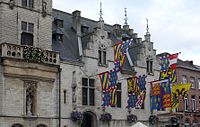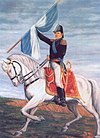Welcome to the Heraldry and Vexillology Portal!


Vexillology (from the Latin vexillum, a flag or banner) is the scholarly study of flags, including the creation and development of a body of knowledge about flags of all types, their forms and functions, and of scientific theories and principles based on that knowledge. Flags were originally used to assist military coordination on the battlefield, and have evolved into a general tool for signalling and identification, particularly identification of countries.
Heraldry encompasses all of the duties of a herald, including the science and art of designing, displaying, describing and recording coats of arms and badges, as well as the formal ceremonies and laws that regulate the use and inheritance of arms. The origins of heraldry lie in the medieval need to distinguish participants in battles or jousts, whose faces were hidden by steel helmets.
Selected article

Heraldry in its most general sense encompasses all matters relating to the duties and responsibilities of officers of arms. To most, though, heraldry is the practice of designing, displaying, describing, and recording coats of arms and badges. Historically, it has been variously described as “the shorthand of history” (Fox-Davies) and “the floral border in the garden of history” (Moncreiffe & Pottinger). The origins of heraldry lie in the need to distinguish participants in combat when their faces were hidden by iron and steel helmets. Eventually a system of rules developed into the modern form of heraldry. Though heraldry is nearly 900 years old, it is still very much in use. (more...)
Selected flag

The Flags of Puerto Rico represent and symbolize the island and people of Puerto Rico. The origins of the current flag of Puerto Rico, adopted by the Commonwealth of Puerto Rico in 1952, can be traced to 1868, when the first Puerto Rican flag, "The Revolutionary Flag of Lares", was conceived by Dr. Ramón Emeterio Betances and embroidered by Mariana "Brazos de Oro" Bracetti. The exiled Puerto Rican Revolutionary Committee chose the Flag of Lares as their standard. In 1892, the Revolutionary Committee adopted a design modeled after the Cuban flag. The new flag consisted of five equal horizontal bands of red (top and bottom) alternating with white; a blue isosceles triangle based on the hoist side bears a large, white, five-pointed star in the center.
The display of a Puerto Rican flag was outlawed and the only flags permitted to be flown in Puerto Rico were the Spanish flag (1492 to 1898) and the flag of the United States (1898 to 1952). In 1952, the Commonwealth of Puerto Rico declared the flag originally designed in 1892 to be the official flag, but without specifying the tones of colors to be used. The color of the triangle that was used by the administration of Luis Muñoz Marín was the dark blue that is used in the flag of the United States, instead of the original light blue, thus creating a political controversy which has lasted throughout the years. (more...)
Selected biography

John Philip Brooke Brooke-Little, CVO, FSA, FHS, (6 April 1927 –13 February 2006) was an influential and popular writer on heraldic subjects and a long-serving officer of arms at the College of Arms in London, England. In 1947, while still a student, Brooke-Little founded the "Society of Heraldic Antiquaries." This organization is now known as The Heraldry Society and is recognized as one of the leading learned societies in its field. He also served as the society's chairman for 50 years until 1997 and then as its President. (more...)
Selected picture

The town hall of Dendermonde, a city in Flanders, displaying heraldic banners.
Did you know...
- ...that the Flag of Macha (pictured) is considered to be the first physical flag of Argentina?
- ...that the herald Robert Glover was appointed to the office of Norroy King of Arms jointly with his 82-year-old father-in-law William Flower in 1580?
- ...that the coat of arms of Andalusia bears the Pillars of Hercules, the ancient name given to the promontories that flank the entrance to the Strait of Gibraltar?
- ...that from 1850 until 1872, the Party Processions Act made it illegal to parade with music, flags or banners in Ireland?
- ...that the Alphyn, a rare heraldic creature, was the badge of the Barons de La Warr?
Related portals
Major topics and navigation
|
|
|
Heraldry Web resources
Authorities
- Belgium - The Council of Nobility, Flemish Heraldic Council and Council of Heraldry and Vexillology of the French Community
- Canada - Canadian Heraldic Authority and see also Public Register of Arms, Flags and Badges
- England, Wales, and Northern Ireland - The College of Arms
- Ireland - The Office of the Chief Herald of Ireland
- Netherlands - High Council of Nobility
- Portugal - Instituto da Nobreza Portuguesa
- Scotland - The Court of the Lord Lyon
- South Africa - South African Bureau of Heraldry
- Sweden - National Board of Heraldry, The National Archive
- United States Army - The United States Army Institute of Heraldry
Societies
- Greek Heraldry Society
- The Academy of Heraldic Science Czech republic
- The American College of Heraldry
- The American Heraldry Society
- The Augustan Society
- The Australian Heraldry Society Inc.
- Bulgarian Heraldry and Vexillology Society
- The Center for Research of Orthodox Monarchism
- Cambridge University Heraldic and Genealogical Society
- Chiltern Heraldry Group
- The College of Dracology
- Croatian Heraldic and Vexillologic Association
- The Finnish Heraldic Society
- Fryske Rie foar Heraldyk
- Hellenic Armigers Society
- Guild of Heraldic Artists
- Genealogical Society of Ireland
- Heraldry Research Institute (Japan)
- The Heraldry Society
- The Heraldry Society of Africa
- The Heraldry Society of New Zealand Inc.
- The Heraldry Society of Scotland
- The Heraldry Society of Southern Africa
- The Institute of Heraldic and Genealogical Studies
- The International Association of Amateur Heralds
- Italian Center of Vexillological Studies
- Lancashire Heraldry Group
- Macedonian Heraldry Society
- New England Historic Genealogical Society Committee on Heraldry
- Norwegian Heraldry Society
- Oxford University Heraldry Society
- Polish Heraldry Society
- Polish Nobility Confederation
- Real Academia Matritense de Heráldica y Genealogía - Royal Academy of Heraldry and Genealogy of Madrid
- Romanian Institute for Genealogy and Heraldry
- The Royal Heraldry Society of Canada
- The Russian College of HeraldryThe Russian College of Heraldry
- Serbian Heraldic Society
- Societas Heraldica Scandinavica
- Societas Heraldica Slovenica
- Swedish Heraldic Society
- Ukrainian Heraldry Society
- Royal Association Genealogical and Heraldic Office of Belgium
Vexillology
Software
- Coat of Arms Visual Designer web-based program
- Puncher Heraldry Program
- Blazonry Server - pyBlazon
- DrawShield - creates SVG shield or arms image from blazon
- CoaMaker - web-based tool
- Blazon95 and BLAZONS! 2000, older Windows applications
- Heraldicon
Texts
- Heraldry, historical and popular : with seven hundred illustrations (1863)
- A Complete Guide to Heraldry (1909)
Other
Wikimedia
The following Wikimedia Foundation sister projects provide more on this subject:
-
Commons
Free media repository -
Wikibooks
Free textbooks and manuals -
Wikidata
Free knowledge base -
Wikinews
Free-content news -
Wikiquote
Collection of quotations -
Wikisource
Free-content library -
Wikispecies
Directory of species -
Wikiversity
Free learning tools -
Wikivoyage
Free travel guide -
Wiktionary
Dictionary and thesaurus











